
Harrow and Hillingdon Geological Society
Insights from Indonesia
Home | Monthly Meetings | Field Trips | Exhibitions | Other Activities | Members Pages | Useful Links
What controls where volcanoes form? Insights from Indonesia
Adam Pacey
The speaker had worked with Colin Macpherson and Ken McCaffrey on this subject as a Masters project at the University of Durham and was now doing a PHD at Imperial College and the Natural History Museum. Volcanoes form at 2 types of active plate margins, the mid-ocean ridges and subduction zones. The talk concentrated on island arc volcanoes at subducting plate margins with particular reference to Indonesia.
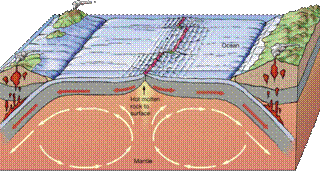
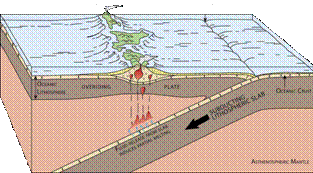
Plate tectonics & volcanism Subduction & island arc volcanism
Hydration reactions at the sea floor generate chlorite and serpentine and, when these descend into the mantle in the subducting ocean lithospheric slab, dehydration occurs with fluid release, which lowers the melting point sufficiently for magma to form. Island arcs form at systematically different distances from the trench, which are controlled by the dip of the subducting slab. Geophysics from long-wave earthquakes enable the measurement of the slab depth. In any arc segment, there is a constant depth to the slab and a systematic variation between arc segments of 65-130km for the depth of the slab. Current theories are twofold:
- Volcanism occurs above the highest percentage of melting (Grove et al, 2005).
- Melting is widespread along the upper edge of the slab and the arc forms above the solidus ‘nose’ (England & Katz, 2010); or
The former is now considered to be wrong and the latter does not really apply.
Sunda arc volcanism
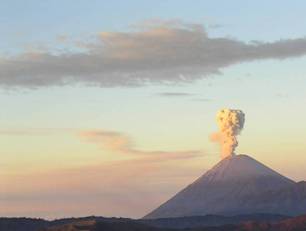
Mt Semeru, Java
Looking at the Sunda arc in Indonesia, the volcanoes generally occur in straight lines. This gave rise to the hypothesis that rising magma may be focused by lithosphere-scale stresses in the over-riding plate and the volcanism follows lineaments. This was tested by mapping all the volcanic structures in the Sunda arc, objectively identifying and assessing the linear arrangement and relating it to the stress field.
The Sunda arc stretches from Sumatra, through Java and Bali to Flores. A 90m-pixel elevation model was used to identify volcanic structures, the first question being – What constitutes a volcanic vent? A critical size was taken at 3km, which is large enough to be significant and representative, can be recognised easily and is verifiable to on-the-ground data. The age and validity of every vent must be correlated to geological mapping to check that it is real and that it is Quaternary in age, since there have been 2 periods of subduction, one currently taking place and one in the Tertiary.
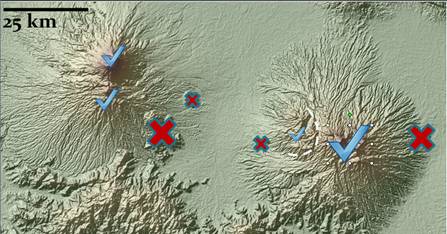
Critical size of vents
Hough transform analysis, a pattern recognition algorithm was used to detect linear features and it produced 4 en-echelon arc segments with correlation coefficients of 0.929. 0.941, 0.952 and 0.774. It is suggested that there may be smaller-scale structural control as there is a systematic trend from identified lineaments which appear to follow second-order mapped structures. When all vents are given equal weighting, small (3-5km) outlying vents can skew the statistics defined by large (30km) volcanoes. Using weighted regression improves the correlation to 0.950, 0.985, 0.963 and 0.853.
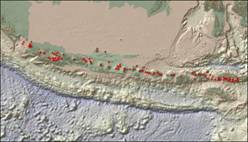
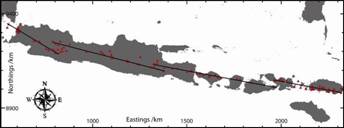
Sunda arc – verified vents En-echelon linear trends from Hough transform analysis
Stress fields
Any stress field, defined uniquely by magnitude and orientation of three mutually orthogonal axes, identifies two planes which experience no shear. Since the earth’s surface experiences no shear, it must contain 2 of the axes, leaving 3 options.
- Maximum compressive stress (σ1) is vertical – normal faulting;
- σ1 is horizontal and minimum compressive stress (σ3) is vertical – thrust faulting; and
- σ1 and σ3 are both horizontal – strike-slip faulting.
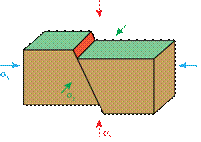
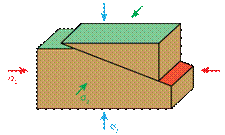
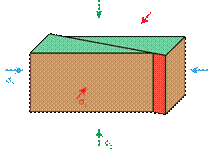
Normal faulings Thrust faulting Strike-slip faulting
For the lineaments to be thrusts, en-echelon geometry is not typical, it is difficult to get a straight surface trace and they are compressive. Tensional normal faulting raises questions about a straight surface trace and vertical σ1 and would be aseismic. Strike-slip faulting could have no surface trace or morphological features and is aseismic. In strike-slip faulting there is often a development of shear features (Riedel shears) before the development of the fault so what you have in the Sunda arc is possibly incipient strike-slip faulting. If we assume the system margins are sub-parallel to tectonic features, these could be dextral Riedel shears. This would be consistent with the Great Sumatra Fault, the lack of surface trace, the en-echelon geometry and the low seismicity but the angle is low. If it is incipient trans-tensional strike-slip faulting, this would lower the angle of Riedel shears and would aid magmatic exploitation. Possible explanations for how this would happen include roll-back of the subducting slab, mantle wedge flow and dynamic topography or self-sustained loading.

Slab roll-back
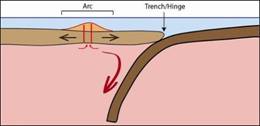
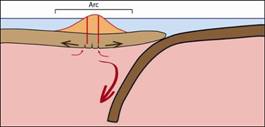
Mantle wedge-flow Self-sustained loading
Conclusions
4 statistically significant (r2>0.85) 400-700 km en-echelon linear trends in volcanism have been objectively identified. These are not explainable via current mantle theories but seem to relate to stress-controlled lithospheric weaknesses and structural focusing of melt into discrete zones of volcanism is a key control over position and distribution of arc volcanoes. Looking at other volcanic arcs world-wide, there may be sim,ilar alignments in Central America and Chile.